
Lenbach Square (Lenbachplatz) is a public space located on the western edge of the historic old town of Munich, on the border with the district of Maxvorstadt and is part of the old city ring.
The space was founded on the site of the demolished Capuchin monastery, which was founded in 1600 and dissolved in 1802.
The square is named in honor of the Munich artist Franz von Lenbach, who became famous for writing portraits of the rulers, famous public figures and celebrities.
Today Lenbachplatz more like a street than a square. Also the area is not a resting place, and is a transport hub with pedestrian sidewalks running along both sides of the square.
The length of "street-square" of Munich is less than 200 m, it stretches from the Karlsplatz square to Maximiliansplatz.
Along the square are historical buildings, there is a large fountain.
House Bernheimer (Bernheimer-Haus) is also known as Barnaulsky Palace (Bernheimer Palace) was built in 1888-1889 by architect Friedrich von Tarsem with a facade in neo-Baroque style that made the building one of the first of its kind, and then a prototype for other buildings of this kind in Munich.
Subsequently the building was extended.
Next to the Palace from 1887 to 1905 was built several stylistically consistent building.
Today, the Palace Bernheimer - a beautiful residential and commercial building.
Building address: Lenbachplatz, 3.

The former headquarters of the Munich stock exchange is a historic building Dating from 1896 to 1898 for Deutsche Bank according to the plans of albert Schmidt in the neo-Baroque style.
The Munich stock exchange was in the building from 1963 to 2007.
During the Second world war the building was partially destroyed and rebuilt by Jacques Lehner in 1948-1949.
Today the building serves as office and commercial building, and it is called "old stock exchange".
The building has an almost square layout with rounded corners corbels, richly structured facade of Sandstone, sculptural decoration and Corinthian columns.
Building address: Lenbachplatz, 2/2A.
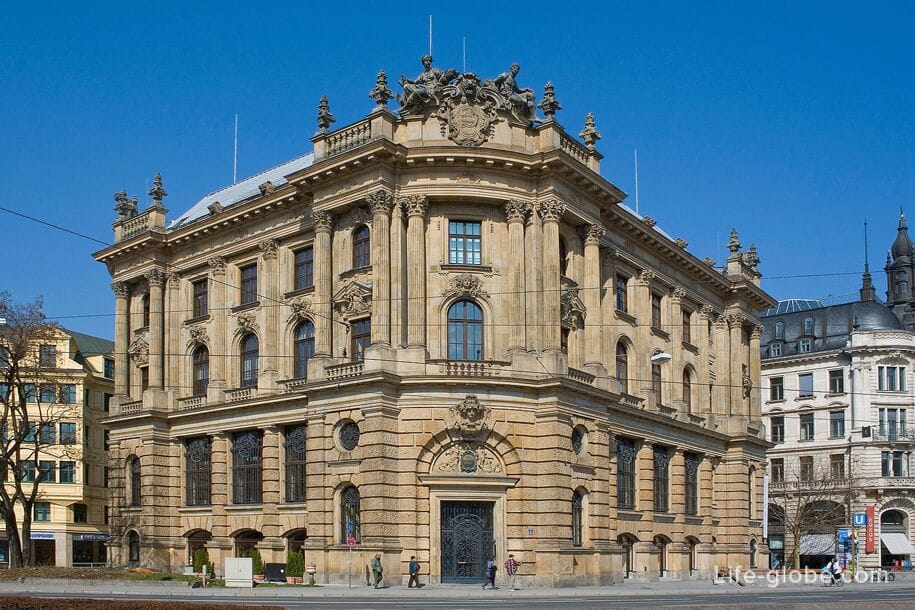
The former Bank building Bayerische Bank was built in 1901 and located at the address: Lenbachplatz, 4.
A former art dealer Bavarian Bank was built in neo-Baroque style by albert Schmidt in the years 1898-1903.
After the Second world war the building was reconstructed Wilhelm Linder in 1946-1951 years.
Building address: Lenbachplatz, 5.
The former building of the Aachen-Munich furniture company for insurance against fire, was built in 1904-1905.
This five-story rear corner with a small corner tower has arched Windows on 1st and 2nd floors, balconies on the corners of 3 and 5 floors and decorated with ornaments.
Building address: Lenbachplatz, 6.
All the above buildings are located near each other, on the West side of the square Lenbach and represent the exquisite architectural ensemble.
Pictured left to right: houses at numbers 2 and 3 at home 4-5-6 visually unified building

The Munich house of artists (Münchner Künstlerhaus) was built from 1893 to 1900 in neo-Renaissance project of the German architect Gabriel von Seidl's and on behalf of the Munich art Association.
The building had a large Banquet hall, and his interiors reflect the influence of the Italian Renaissance (historicism).
During the Second world war the building was destroyed. Prior to October 1961 was partially rebuilt and renovated by the architect Erwin Heinle in cooperation with the construction company Brannenkämper.
In 2001, the Munich house of artists was reorganized into the Fund, which is dedicated to preserving historical and cultural heritage, support of the Munich artists as well as organizes and hosts exhibitions and events.
In the courtyard is a small fountain Conrad Dreher. In the building there is a restaurant. The premises may be leased.
Building address: Lenbachplatz, 8. Website: kuenstlerhaus-muc.
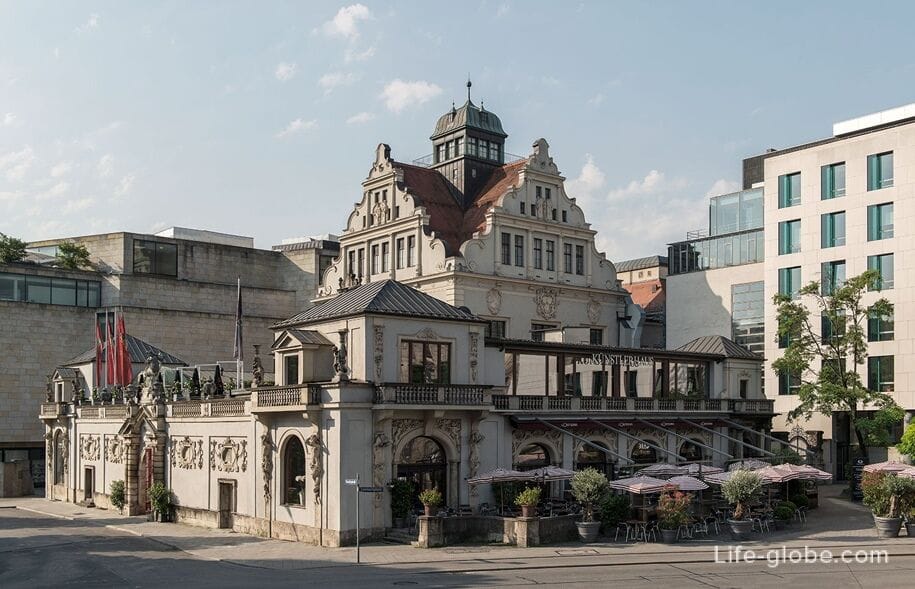
Maxburg (Maxburg) is the only surviving part of the former residence of Duke Maximilian Philipp Hieronymus.
During the Second world war the building was almost completely destroyed. In its place was built a complex of administrative and commercial buildings.
The building with the adjoining tower are an ensemble and is located almost at the intersection of the square Lenbach and streets Pacellistrasse, at: Pacellistrasse, 5 (Pacellistraße). Read more about Macksburg...
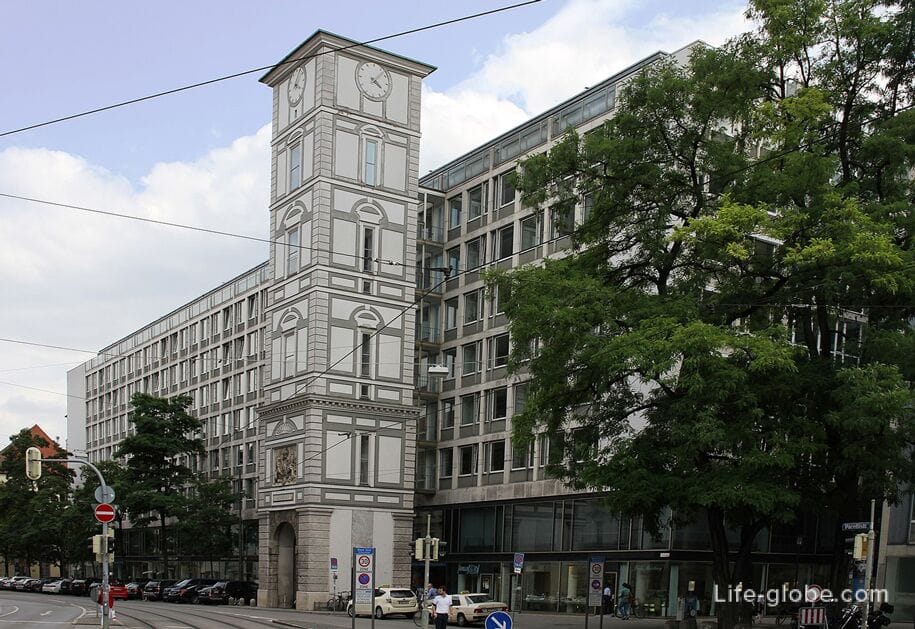
Fountain of Wittelsbach or Wittelsbach fountain (Wittelsbacher Brunnen) is situated on the border of the square Lenbach and Maximiliansplatz.
This fountain is considered the most beautiful fountain in Munich.
The fountain was built in 1893-1895 according to the plans of the sculptor Adolf von Hildebrand, with the help of sculptor Erwin Kurtz in the style of classicism.
The motif of the fountain is an allegory of natural forces of water. Thanks to their discreet, clear and exquisite design, as well as from the point of view of urban planning, the fountain is one of the artistic buildings of Munich.
The basis of the fountain forms a pool in the shape of a semicircle with a width of 25 meters. From the Cup is raised a second pool in the center of which is a two-storey embossed bowl from limestone, which also serves as the pool of the fountain.
The sides to the Central bowl of the fountain adjacent two marble sculptures representing the ancient theme of visualization of human and animal:
on the left the sculpture depicts a young man seated on a water horse with a fish tail and holding with both hands a lump that he was going to quit. This figure is an allegory of destructive force of water, as a hint at the raw power of mountain streams;
- the figure on the right shows Amazon, which sits on rising up from a stream of water the water bull with a fish tail. Left hand she holds a bowl of water. This figure symbolizes the fertile and salutary for human and animal power of water, which appears after its "pacification" and of the trends in the right direction.
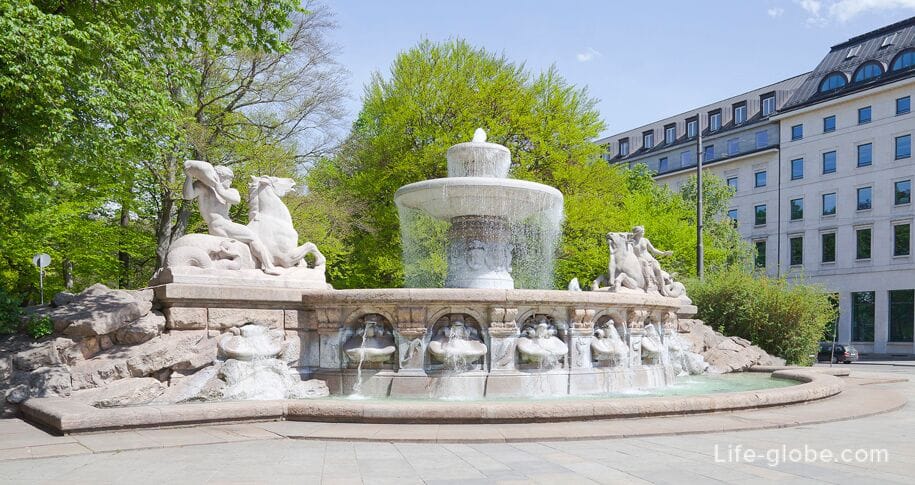
5-star Rocco Forte The Charles hotel overlooking the old Botanical garden.
In the hotel: Spa with indoor pool, sauna, steam bath and fitness room; soundproof rooms with free Wi-Fi; restaurant; bistro with a terrace and a bar; a private garage.
The rooms and suites: air conditioning, flat-screen TV, a bathroom with bath and separate shower. Link to the hotel
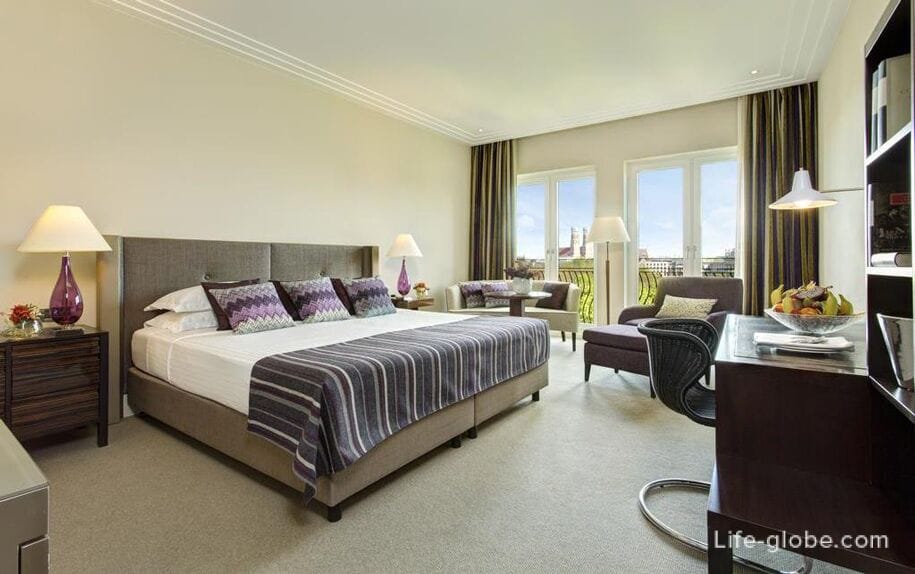
5-star hotel Bayerischer Hof with 5 restaurants, 6 bars and a Spa with a rooftop pool, sauna and gym.
The rooms and suites: air conditioning, high speed Wi-Fi. Complimentary fruit basket and bottle of mineral water. Link to the hotel
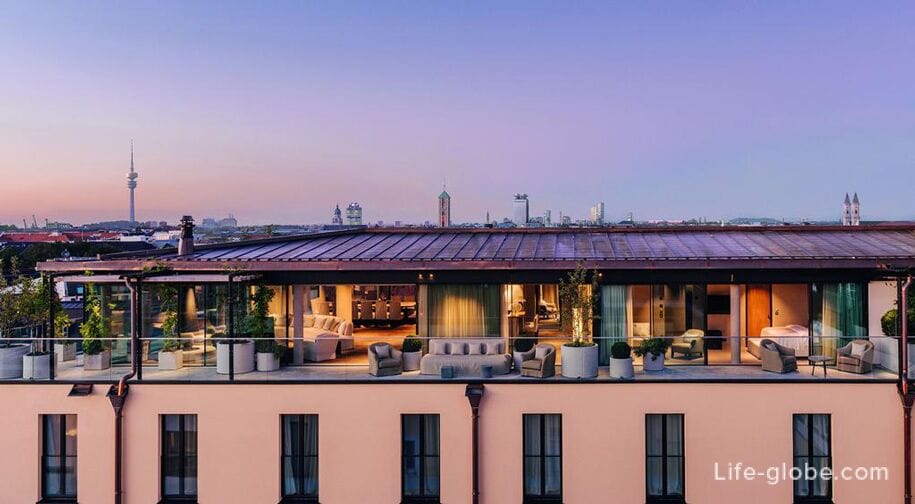
The design hotel Anna features a restaurant, a bar, a summer terrace and offers Soundproofed rooms with free Wi-Fi.
In the rooms: professionally decorated, air conditioning, a flat-screen TV and free Sky channels. The bathrooms have heated towel rails and a Hairdryer. Link to the hotel

The hotel Excelsior features a restaurant, bar and Valet Parking.
The rooms: the layout with antique Bavarian touches, satellite TV with Sky, free Wi-Fi and a private bathroom with toiletries. Link to the hotel

All accommodation in Munich, including the area of Munich and in the city centre, you can view and book here